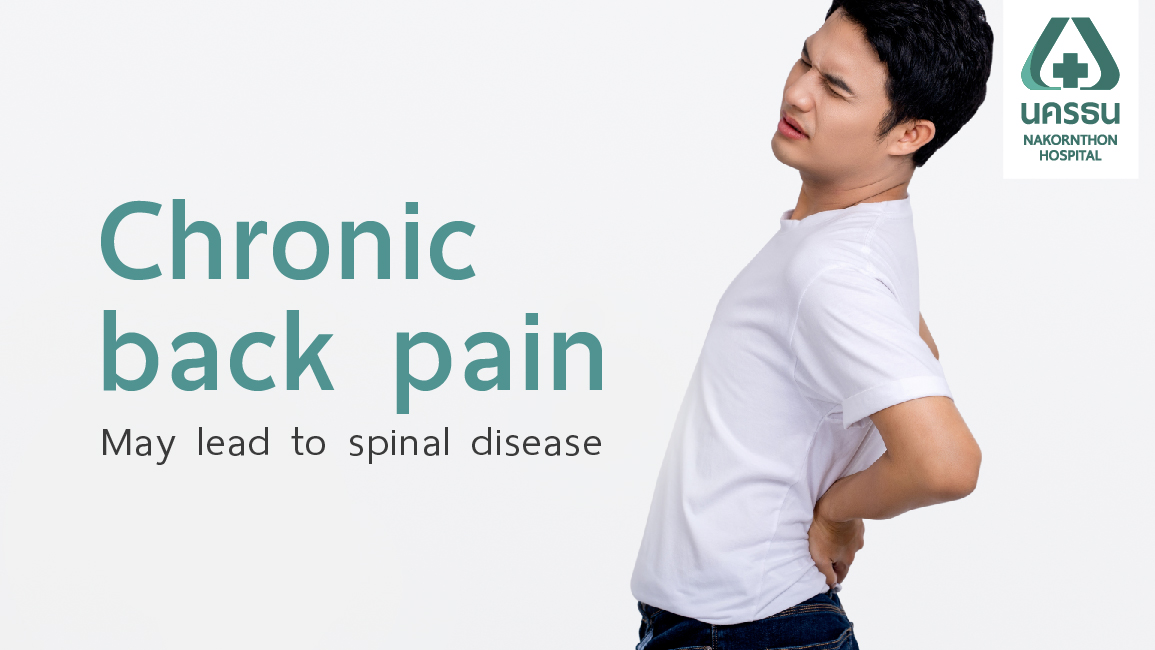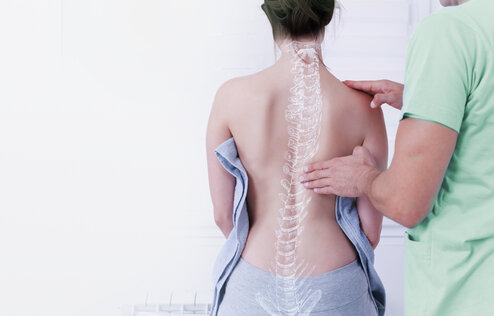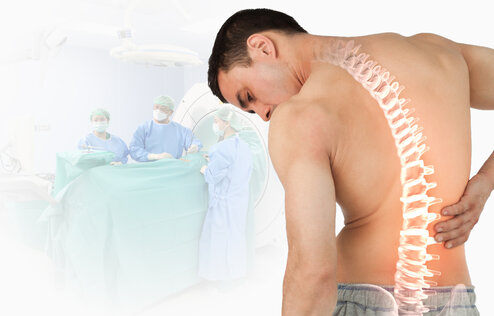
Chronic Back Pain is one of the most common conditions among working adults. Chronic back pain is defined as persistent back pain, either in the middle or lower back, that has lasted for several weeks or months. The pain may be constant or intermittent, meaning that it may have a pain-free period. Most of the time, chronic back pain is caused by muscle strain and overuse of the back muscles. However, it is also possible that chronic back pain indicates other serious problems, such as spinal disorders and spinal infections.
Table of Contents
What is Chronic Back Pain
Chronic back pain is defined as back pain that persists for several weeks to months. Generally, back pain is considered chronic when it has persisted for at least three months. The pain may vary in terms of the degree of intensity, ranging from low to high, depending on the activities. The pain generally occurs in the lower back, before spreading across a wide area and covering the middle back as well. Sometimes, chronic back pain is one of the indications of developing spinal disorders, such as Ankylosing Spondylitis, Spondylosis, or the early stages of HNP (Herniated Nucleus Pulposus). It is recommended that you seek professional advice if the pain does not improve with self-treatment and has worsened over time.
Chronic Back Pain Causes
There are many factors contributing to chronic back pain. Despite the common causes, such as prolonged usage of back muscles and injury, there are other causes involved in developing the condition. Here are some common examples of the causes of chronic back pain.
- Improper body mechanics or incorrect posture. Bad habits are generally prerequisites of chronic back pain. These include deviated spine alignment (hyperlordosis or hyperkyphosis of the spine, depending on which part of the vertebrae affected), muscle imbalance, and postures or movements that you normally perform in everyday life. For example, if you like to sit in a slump posture, the back muscles gradually take its toll in maintaining the posture, and eventually, this will result in back pain. Some movements can cause back pain as well, such as regular lifting or repetitive movements and improper mechanics in performing activities.
- Genetics and aging. It is undeniable and inevitable that genetics and aging also play a major role in this condition. Degenerative changes affect mechanics of the spine and the muscles. We generally lose muscle strength and endurance as we age, along the narrowed disc spaces. Genetics and aging are considered to be prerequisites of chronic back pain as well.
- Muscle deconditioning. Usually, the cause of chronic back pain is the prolonged activities of back muscles. However, it is possible that muscle deconditioning or muscle atrophy contributes to the symptoms. Since the atrophy reduces muscle strength and endurance, the back muscles have to overwork in order to maintain their functions in everyday life: stabilizing the spine and supporting the weight of your body, resulting in chronic back pain.
- Traumatic events or injuries. Traumatic injuries, such as car accidents, falling, and other high-impact events, are critical in developing chronic back pain. The injuries can speed up the degenerative changes or trigger the latent, chronic pain to flare up again, resulting in compensatory movements and difficulty in performing daily activities.
- Overuse and repetition of everyday life. Repetitive movements and overuse of the body are generally the most common causes of chronic back pain. Examples of said activities are driving or sitting for a long period of time, sleeping or sitting in odd positions, lifting objects regularly, and bending the neck or the back frequently.
Chronic Back Pain Symptoms
Chronic Back Pain symptoms are generally similar to typical back pain, with the difference in duration of the pain. The common signs and symptoms of chronic back pain are:
- Mild to severe pain that doesn’t go away. You may have a short duration of pain-free or low-pain period before the pain flares intensely again. The back pain is defined as chronic when it has persisted for 3 months.
- Dull aching or throbbing pain in the back.
- Sharp or stabbing pain. The sensation may radiate to the abdomen or the buttock.
- Aching or burning pain. The sensation may radiate into the thighs or the legs. If there are numbness or weakness sensations, they may indicate neurological deficits.
- Stiffness and soreness of the back.
When to See a Doctor for Chronic Back Pain
Chronic Back Pain can be constant discomfort in your daily life, but you can still manage to perform daily activities. However, there are some signs and symptoms that indicate the need to see a doctor. The symptoms are:
- The pain has become chronic and lasted for more than 3 months. Self-treatments are proved to be unsuccessful and the pain has become worsened as time passes.
- The pain has radiated into the legs consecutively for 2 weeks. It can happen on just one side of the body or both sides. The accompanying symptoms alongside the pain are numbness and weakness.
- The pain gets worse at night.
- The pain gets worse with movements, including rolling to sides, and sitting to standing.
- The pain gets worse when you sneeze, cough, or urinate.
- Unexplained weight loss.
- Urinary or defecation incontinence.

Diagnosis for Chronic Back Pain
A medical history and physical examination are used to diagnose chronic back pain. The doctor may order an additional examination, such as an MRI, to confirm the hypothesis. The MRI is beneficial in terms of producing a high-quality image that shows the state of the structures and impairment boundaries. The image produced from this procedure shows the distinct differences between the structures: the spines, the discs, the spinal nerves, and the soft tissues. The doctor can diagnose the root cause and determine the best treatment for you with the help of MRI images.
Treatment for Chronic Back Pain
Chronic back pain is a condition that can be managed. Mostly, the doctor will prescribe you a non-surgical treatment as an initial treatment, before changing to surgery if the need arises. Non-surgical treatments include physical therapy, medications, spinal injections, and RFA (Radiofrequency Ablation). Surgery may be considered as an alternative if the condition is severe and in need of surgical treatment. Details of each method will be described below.
Physical Therapy
Physical Therapy can help relieve back pain. The program can be varied depending on your condition and your therapist. Normally, the physical therapy sessions include exercises, mobilization, and modalities to relieve pain, such as Therapeutic Ultrasound Therapy and Electrical Stimulation (ES). In addition, your physiotherapist may recommend retraining your posture, testing the limits of your pain tolerance, and prescribing an exercise program to help with the condition. The exercises generally include flexibility exercises, aerobic exercise, and core-strengthening exercises. Ergonomic adjustments in daily life may be suggested as well.
Medications
Usually, the doctor will prescribe you analgesics, anti-inflammatory drugs, muscle relaxants, and other medications to relieve pain. It is suggested that you take prescribed medications and tell your doctor if you have allergies. Some medications have side effects and are not intended for prolonged use. Consult your doctor if the medication does not improve the condition.
Surgery
Surgery may be needed in some severe cases. The most common surgical techniques used to treat chronic back pain are endoscopic back surgery and TLIF surgery (Transforaminal Lumbar Interbody Fusion).
Endoscopic Back Surgery uses an endoscope inserted into the spine to treat the condition. The benefits of this technique are a small incision, a low level of pain after surgery, and low risks of complications. The patients undergoing this procedure generally recover fast.
TLIF surgery, on the other hand, is performed with the purpose of fusing the vertebrae together. The surgery may use O-arm navigation, the novel technology used to navigate during surgical procedures, in order to increase the success rate.
Injection-based Treatments
If medications and physical therapy are ineffective, your doctor may prescribe injection-based treatments. The injections are typically known as nerve blocks or epidural steroid injections. Some may call it a nerve ablation or a spinal injection. This procedure is commonly used when the root cause of chronic back pain has been determined. The injection will relieve pain and reduce inflammation, but it is not recommended as a long-term solution. The doctor may need to thoroughly examine your health before determining whether this procedure is suitable. Normally, the spinal injection is not to be used in isolation.
Prevention for Chronic Back Pain
Chronic back pain is both treatable and preventable. Normally, prevention includes ergonomic adjustments and lifestyle changes. Here are some examples of how to prevent chronic back pain.
- Maintain a healthy weight.
- Maintain a good posture.
- Avoid sitting or standing for a long period of time, including while driving and working on computers. Try to take a small break, frequently, to let your muscles relax.
- Avoid lifting heavy objects or lifting on a regular basis.
- Avoid repetitive movements such as bending your back.
- Exercise regularly. Aerobic exercise is good for your overall health because it involves large muscle groups. Strengthening exercises, such as core stabilization exercises, are suggested to prevent back pain as well.
- Quit smoking.
Chronic Back Pain Conclusion
Chronic Back Pain is defined as an ache that occurs anywhere in the back and has persisted for at least 3 months. Other serious conditions, such as HNP, spondylosis, and spondylolisthesis, can be indicated by the symptoms. Generally, chronic back pain will be initially treated with non-surgical treatments. If non-surgical treatments prove unsuccessful, surgery may be considered. It is recommended that you seek professional advice in order to get a precise diagnosis and proper treatments suited to your health condition.
For more information, please contact:
- - Website : https://en.nakornthon.com
- - Facebook : Nakornthon Hospital - International Patient
- - Line : @nakornthoninter
- - Tel: 02-450-9999 (Available 24 hours)
Free Online Consultation
Article of Spine Center






